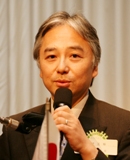��Education in Finland and its Historical Background��
April 15, 2009
Mr. Masahiro Kimura
Senior Commercial Officer, Finland Trade Center, Embassy of Finland
 ��The keyword underlying the educational background in the Republic of Finland is ��identity supported by nature and culture.��
��The keyword underlying the educational background in the Republic of Finland is ��identity supported by nature and culture.��
��The geopolitical location of being sandwiched between Russia on the east and Sweden on the west has inflicted a history of suffering to this country, with an area 90% of Japan but with a population of only 5.2 million. Finland was governed by Sweden, the largest country in Northern Europe, from the 12th to 19th Century. In 1809, Finland became an autonomous Grand Duchy in the Russian Empire till 1917, when it gained independence and became the Republic of Finland. This long history of suppression by other ethnic groups made the Finns concentrate on how to establish and maintain their identity.
There are similarities between the Finns and the Japanese coexisting with nature.
��The epic ��Kalevala�� and the symphonic poem ��Finlandia�� composed by Jean Sibelius represent the cultural identity of this country, the former made the then second-grade Finnish language gain recognition as a cultural language, and the latter played an important role of promoting independence. Today Finland is well-known for its architectural design, nursing care for the elderly and welfare, Moomin, world-famous literature of fantasy which illustrates Finnish philosophy of life, and not to mention Santa Claus.
��The concepts of ��fairness�� and ��equality�� underlie the social structure. According to the assessment by Transparency International, Finland is ��a country with the lowest rate of wrongdoing,�� where people trust the ��fair�� government and nation. Finland realized gender equality earlier than any country of the world by giving women universal suffrage for the first time in Europe in1906.
��The history of education dates back to the Swedish era, when education was based on evangelization and children from the ruling class were educated in churches. In 1686, education became compulsory nationwide. The ��National School Law�� of 1866 became the model for Western school system, stipulating that the authority of the church should be transferred to local municipalities. 16 national high-schools providing coeducation on social affairs were founded in 1889, and in 1902 a national movement unfolded under the slogan of ��learning through life,�� the forerunner of lifelong education. When Finland gained independence, the compulsory education law was enacted in 1919, followed by the first free school meal system under the school meal law in 1943.
��The current educational system is 9 years of compulsory primary education, 3 years of secondary education, followed by higher education of 5 years in universities or 3-4 years at polytechnics. One year of supplementary curriculums is prepared for slow-learners in primary education. School tuition is free from elementary up to graduate school, and the government subsidies 80% of students�� boarding fees, and substantial scholarship schemes are available.
��Education has two missions, one being ��Educational�� and the other ��Instructional.�� The latter puts emphasis on stimulating inward formation of a person through rational self-evaluation and self-control. All educational measures and efforts were made to nurture useful personnel who will eventually support the country.
��Finland achieved high scores in the 2003 PISA in reading, science, mathematics and problem-solving ability. Educational specialists around the world are rushing to Finland, trying to find out the key to this success.
��Finland gained high evaluation in reading as early as 2000. Being conscious of their identity, the Finns cherish their own language, which leads to high reading capability. In fact, they are well-known as booklovers.
��To further improve reading capability, the LUKU-Suomi Program was implemented in 2001, which includes reading and writing skills, improvement of school libraries, training for deductive and critical reading in all subjects, learning based on writing, etc. The LUMA Program for mathematics, implemented in 1996, also proved to be effective.
��After analyzing its own data, the ��educational reform program based on the concept of equality�� was formulated in Finland. The education in this country is ��non-selective��, and this concept of ��equality�� is both in terms of educational opportunity and scholastic results. As a result of the extensive educational reform in 1970, classes are small in size, limited to 20 students for Fin language lessons. Teachers grasp the aptitude of each student and tailor the curriculum to meet individual needs to maintain a certain level of academic achievement.
��It is said that ��highly qualified teachers are the key to success.�� In Finland all teachers have a master��s degree. Screening of textbooks and official guidelines for school-teaching were abolished, while authority is delegated to schools to encourage diversification and differentiation of the curriculum.
��How to maintain the level of industrial activities and productivity is a common issue for all aging nations. The educational initiative in Finland can possibly be a solution, as it re-educates laborers to secure elderly labor forces. The ultimate target of education in Finland is to establish a solid nation with a firm identity so as never to be invaded by other countries.